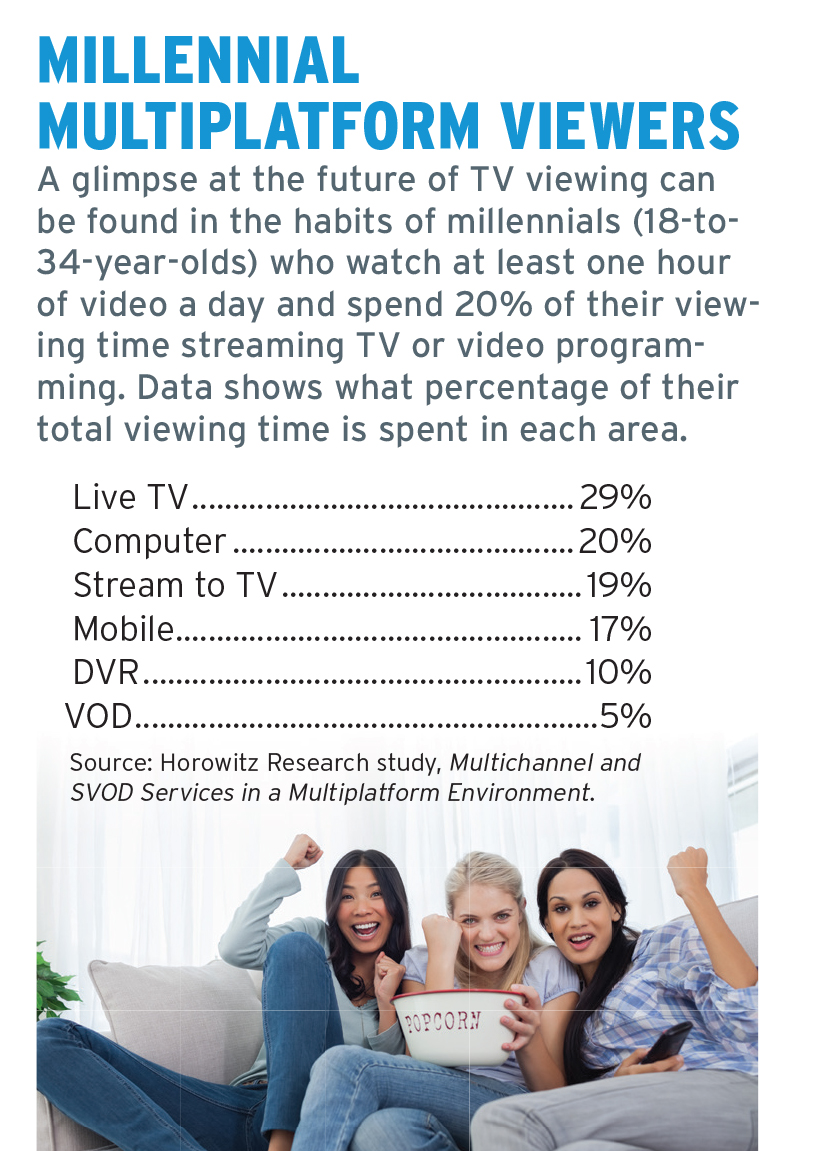Youth Will Be Served, But ‘How’ Remains In Question

Related: Millennials by the Numbers
It is arguably one of the most important issues facing the future of TV—the way swiftly evolving viewing options have placed millennials at the content crossroads. One road leads to connected multichannel TV viewing, the other to a stream of unconnected digital options.
Many press accounts see millennials taking the newer route, tagging their embrace of over-the-top video as long-term trouble for the $150 billion TV industry. Others argue that young people have always been slower to subscribe, and that once they get out of school and start families, they’ll return to multichannel TV, and all will be well. The reality, as usual, is far more complex, as new key data points suggest.
Despite widespread predictions of an imminent collapse, total multichannel TV subs fell by only 0.2% in 2013, and only 0.1% in 2014, according to research from MoffettNathanson, with similar small declines being reported by SNL Kagan and Magna Global.
That prompted Magna Global to revise upwards its estimates of U.S. multichannel TV subs. It is now predicting that the number will fall from 103.6 million in 2014 to 103.4 million in 2015 and 102.9 million in 2018. That would still be above the 101.1 million subs reported in 2005 but below the peak of 104.3 million U.S. subs in 2009.
It has long been known that younger people have lower levels of multichannel subscriptions than the general population, and some data suggests that their higher usage of streaming video makes them even less likely to subscribe. “Their penetration rates have been declining,” said Dounia Turrill, Nielsen senior VP, Insights. Overall, the number of people aged 18-34 with a multichannel subscription fell about 2.3% between the fourth quarter of 2013 and the fourth quarter of 2014 to 57.8 million, Nielsen reports. Interestingly, declines are also occurring in the number of millennials in broadcast-only homes and among those with only broadcast and broadband, two categories that tend to include cord-cutters and cord-nevers.
Tech and TV
Broadcasting & Cable Newsletter
The smarter way to stay on top of broadcasting and cable industry. Sign up below
There is little doubt that younger age groups such as millennials have embraced smartphones and streaming video devices much faster than the general population. A recent survey by Frank N. Magid Associates, for example, found they spend about 32% of their video viewing time with streaming video, nearly as much as their live TV viewing (34%), notes Maryann Baldwin, VP at the firm.
Nielsen meanwhile is reporting a precipitous decline in their traditional TV viewing. Between the fourth quarter of 2011 and the fourth quarter of 2014, the amount of live and on-demand TV viewing fell by nearly five hours a week by those aged 25-34 and nearly seven hours for those aged 18-24.
Those figures are, however, contested. Programmers contend these declines reflect the fact that TV viewing on mobile phones and other devices is not being measured.
While the number of multichannel subs is relatively flat, Magna Global estimates that the number of homes that primarily access video content over the Internet will grow from 7.3 million in 2014 to 9.4 million this year, and to 15.9 million in 2018.
At the same time, pay-TV subs have not kept the same pace, noted MoffettNathanson in a recent report. “It appears that 1.4 million homes [in 2014] have cut [or never had] the cord, the highest 12-month total yet,” the analysts noted.

A variety of surveys have also found that millennials are much more likely to cut the cord and rely on over-the-top video, noted Paula Minardi, digital TV marketing manager, Ooyala, who authored a recent report on the subject.
But recent surveys from Magid and Horowitz research also highlight widespread interest in TV programming. Horowitz Research, for example, found that over three quarters of those aged 18-34 cited the value of having a large variety of channels as one of the key advantages of a multichannel subscription. “Millennials are an opportunity wrapped in a challenge,” said Howard Horowitz, president of the firm, who believes that networks and operators have an opportunity to thrive in the emerging OTT landscape if they craft offerings and services targeted to the habits of millennials.
The Magid 2015 Video Entertainment Study also found that millennials were willing to pay for content even though they have greatly increased their use of streaming media. About 60% said they would rather pay for a subscription or a la carte service than get their content through free ad-supported services.
This survey, which covered online users, also found that 88% had a multichannel service, though like other recent surveys it found many were considering cutting or reducing those services. While Magid does not believe large numbers of this group will cut the cord in the short term, about 48% of the millennials listed cost as a reason to consider cord-cutting and 73% cited subscription video-on-demand services as a potential reason, Baldwin said.
“We do really see this as a wide open field for anyone who can take the time to understand this generation and make sure that they are delivering on their ideals and expectations,” she added.
“Millennials are willing to pay for content,” said Sharalyn Orr Hartwell, executive director of Frank N. Magid Associates. “But they want to have it tailored in a way that makes sense to them. They have higher expectations of what they want.”
That makes features to personalize the content and to have the content available whenever they want to watch it more important than ever, several researchers say. “It is not just about money,” Orr Hartwell said. “It is more about whether they should pay for a multichannel subscription because they have other options.”
She also stressed the diversity of the millennial generation. “Two-thirds of them are in what you might call ‘traditional adult life stages,’” she said. “They are either parents or they are working. When people talk about millennials, they aren’t the college student or a kid who is living in his parent’s basement.”
While age groups remain an incredibly important issue, researchers also stress the increasing importance of ethnic diversity.
Howard Horowitz notes that surveys conducted by Horowitz research going back many years have shown both the growing size of the ethnic population and the fact that they are much heavier users of digital media than the general population.
“You can’t talk about millennials and the changing use of media without talking about multicultural,” he said. “Along with age, there is a change in the cultural composition of American viewing and the consumer audience that makes the multicultural point of view essential.”
Horowitz also stressed the behavioral complexity of the audience in assessing the use of video. In a recent “State of Viewer Segmentation” report, they divided viewers into seven segments. Those segments that tend to view TV programs in more traditional ways accounted for about 69% of the audience, with 31% falling into newer patterns of TV viewing including much higher levels of streaming.
These newer groups tended to skew younger. Millennials comprised about 53% of the “modern multichannels” category that made up 15% of the total TV audience and 8% of the “modern families” segment (8% of the total TV audience).
The 18-34 age group also made up 53% of the “untethered curators” (8% of the total TV audience) that fell into the cord-cutter, cord-shaver and cord-never categories.
Horowitz emphasized, however, that the modern multichannel and modern family categories that have embraced streaming media and newer video delivery platforms are also heavy TV viewers with high penetrations of multichannel subscriptions. Those two younger-skewing categories make up 23% of the total TV viewing audience vs. 8% of the “untethered curators” that have abandoned multichannel TV. They are also a prime target, he believes, for services such as TV Everywhere that can better cater to their digital habits.
In addition, there is a lot of common behavior cutting across age groups. To better understand the over-the-top video and cord-cutters, Horowitz recently surveyed a group of people who watch at least an hour of TV and video content a day and spend at least 20% of their viewing time streaming TV and video content to their TV, computer or mobile device.
This group, which makes up about 31% of the total TV audience, skews young, with millennials making up approximately 55% of the sample.
But within a group that has embraced the most advanced digital technologies, there is very little difference in the viewing of TV programming between 18-34-year-olds and the general population.
Within these multiplatform viewing groups, millennials spend about 44% of their time viewing on traditional TV platforms (live TV, DVR and VOD) vs. 56% on streaming and digital media. This is only slightly higher than the 46% of time spent by the total population on traditional TV and the 54% all age groups spent viewing TV programming through streaming and newer media platforms.
Others suggest that some of the terminology around the whole “cord-cutting” debate is itself misleading. Dounia Turrill at Nielsen notes that broadband-only homes have increased dramatically among millennials, as the number of 18-34-year-olds having broadband-only services more than doubled from 1.6 million in the fourth quarter of 2013 to 3.3 million in the fourth quarter of 2014.
But the broadband-only category is best viewed as another delivery platform, she argued, much like the arrival of telco-delivered services in the mid-2000s or satellite services in the 1990s. “It is a big change and millennials are adopting it at a faster rate than other demos but it is in essence another delivery channel.
“I personally stay away from the term cord-cutters because there are very few people who are genuinely cord-cutters—people who have no interest or the money to have a cord,” she continued. “We have added a cord and that is the broadband connection. It has become another vehicle for delivering your content that you have to embrace.”
